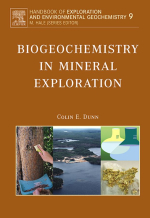Добрый день, Коллеги. Важное сообщение, просьба принять участие. Музей Ферсмана ищет помощь для реставрационных работ в помещении. Подробности по ссылке
Biogeochemistry in mineral exploration / Биогеохимия в разведке полезных ископаемых
Vascular land plants have been evolving for over 425 million years. During that long period they have adapted to survive a remarkably wide range of both physical and chemical conditions. Mechanisms have evolved to absorb and scavenge chemical elements and translocate them through roots into stems, twigs, bark, foliage, flowers, cones and seeds. Some species have developed defences that screen and exclude at the soil/root interface, or at barriers within a plant, those elements that are either not required for metabolic function or are harmful to development. Other species accumulate selected elements and use them to ward off insects and/or diseases. For example, the Douglas-fir has a propensity to accumulate arsenic. Since there is no known metabolic function for this usually toxic element it can be assumed that, until shown otherwise, it is using the arsenic as a defence against either predatory creatures or diseases. Thus, the enrichment of arsenic in Douglas-fir is a facet of knowledge that can be used to advantage by the mineral explorationist, since arsenic is so commonly associated with many metal deposits, especially gold. <...>




